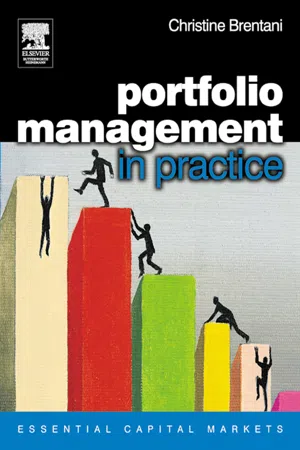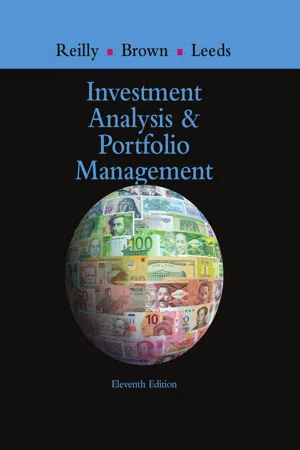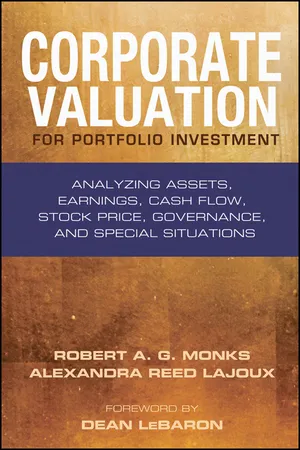Business
Stock Valuation
Stock valuation is the process of determining the intrinsic value of a company's stock. It involves analyzing various financial metrics, such as earnings, cash flow, and growth potential, to assess whether a stock is undervalued or overvalued. Common methods of stock valuation include price-to-earnings ratio, discounted cash flow analysis, and comparable company analysis.
Written by Perlego with AI-assistance
Related key terms
1 of 5
10 Key excerpts on "Stock Valuation"
- eBook - PDF
- Robert Parrino, David S. Kidwell, Thomas Bates, Stuart L. Gillan(Authors)
- 2021(Publication Date)
- Wiley(Publisher)
When stock prices rise or fall, how do investors or financial managers know when it is time to sell or buy? In other words, how can they tell if the market price of a stock reflects Stock Valuation CHAPTER 9 Andrey_Popov/Shutterstock.com LEARNING OBJECTIVES 1. List and describe the four types of secondary markets. 2. Describe the two types of stock securities, and explain why many financial analysts treat preferred stock as a special type of bond rather than as an equity security. 3. Describe how expected future cash flows, discounted at the required rate of return, determine the value of common stock. 4. Describe how the general dividend-valuation model values a share of stock. 5. Discuss the assumptions that are necessary to make the general dividend-valuation model easier to use, and use the model to compute the value of a firm’s stock. 6. Explain why g must be less than R in the constant- growth dividend model. 7. Explain how valuing preferred stock with a stated maturity differs from valuing preferred stock with no maturity, and calculate the price of a share of preferred stock under both conditions. 9-2 CHAPTER 9 Stock Valuation its true value? One approach is to develop a stock-valuation model and compare the value estimate from the model with the market price. If the market price is below the estimate, the stock may be undervalued, in which case an investor might decide to buy the stock. Alterna- tively, financial models can help inform an investor’s decision to sell a stock. In this chapter, we develop and apply stock-valuation models that enable us to estimate a stock’s value. These models are similar to those used in financial markets around the world. Chapter Preview This chapter focuses on equity securities (stocks) and how they are valued. We describe the market in which stocks trade and discuss several valuation models. These models tell us what a stock’s price should be. - eBook - ePub
- Scott Kays(Author)
- 2011(Publication Date)
- Wiley(Publisher)
CHAPTER 10 Valuing Stocks Most investors utilize simplistic valuation techniques that require little time and effort. As we will see shortly, most of those methods are flawed and frequently yield inaccurate results.Faulty analysis can produce two types of poor investment decisions: Valuing a company too richly increases the probability you will overpay for it. Conversely, significantly undervaluing a security may cause you to pass on a compelling investment opportunity because you think its price is too high. Without a reasonable idea of what a firm is worth, obtaining a strong return from an investment becomes a matter of chance.Computing a stock’s fair value does not so much establish a single number that represents the company’s exact worth as it helps you determine the business’s worth to you—it tells you what you can pay for the firm and still generate the return you need. Stated differently, the intrinsic value figure places a worth on a security’s projected cash flow based on the available alternatives. Calculating stocks’ fair values also lets you compare the relative valuations of companies to each other.Since the cash flows of corporations drive their values, a time-tested method for determining a firm’s worth involves calculating a current value for all of its expected future income. The math used to calculate the present value of a firm’s future earnings is relatively simple, but it requires an understanding of two basic concepts: (1) the future value of a present sum of money and (2) the present value of a future income stream.THE FUTURE VALUE OF MONEYWould you rather receive $1 today or $1.10 a year from now? The answer depends on the return you can earn on $1. If you can earn 7 percent, today’s $1 would be worth $1.07 a year from now, making the guaranteed $1.10 more attractive. Conversely, if you can invest at 15 percent, taking the $1 now makes more sense.Let’s assume you can invest at 7 percent. The future value of $1 in one year would be $1.07. The $1 would grow to $1.14 in two years, and so on. By varying the interest rates and time periods, you can develop a future value table, such as the one found in Table 10.1 - eBook - PDF
Healthcare Finance
Modern Financial Analysis for Accelerating Biomedical Innovation
- Andrew W. Lo, Shomesh E. Chaudhuri(Authors)
- 2022(Publication Date)
- Princeton University Press(Publisher)
136 6 Valuing Stocks W e now turn to the valuation of publicly traded companies using the present value concepts we’ve developed so far. Financially speaking, stocks are se- curities that represent shareholder ownership in a corporation. For this rea- son, stocks are often also called equities. Like bonds, stocks can be valued as a sequence of cash flow payments, discounted at the appropriate opportunity cost of capital. In contrast to bonds, which pay out fixed cash flows at predefined dates, stocks pay out their cash flows in the form of dividends, which are uncertain in both timing and amount. Dividends are cash distributions from a portion of a company’s earnings to its shareholders. When and how much is paid out is decided by a company’s board of directors (a group of individuals elected to represent shareholders) and often depends on the company’s current cash requirements and in- vestment opportunities. In addition to dividends, shareholders can also realize a gain in value if a stock’s price increases over time. An increase in a stock’s value through price appreciation is called a capital gain. For example, early-stage biotech companies—most of which aren’t yet generating any revenues—don’t generally pay dividends to their shareholders. Such companies conserve their cash so they can invest in ongoing and new projects. If these projects achieve their milestones (e.g., passing through the phases of clinical de- velopment and eventually achieving FDA approval), and begin generating revenues at some point, investors will expect with greater certainty that the firm will pay dividends in the future. This expectation will be reflected in higher share prices. Before we turn to models that show us how to value stocks and forecast dividends, we first need to discuss the legal characteristics of equities. Throughout this textbook, we’ll see how this legal structure often creates the proper incentives to catalyze inno- vation in the healthcare industry. - eBook - PDF
Investments
Analysis and Management
- (Author)
- 2016(Publication Date)
- Wiley(Publisher)
T he moment you have been waiting for is almost at hand. Having prepared yourself to manage your inheritance by learning about topics such as mutual funds, short selling, portfolio theory, and the capital asset pricing model (CAPM), you are now anxious to get out there and buy some stocks. After all, you know someone who bought Amazon in 2009 at $80 and it went to over $300 , and you know for sure this person is not the brightest bulb in the chandelier. On the other hand, you have read horror stories about the folks who bought technology stocks which subsequently collapsed—and some of these people were really smart. So there must be more to equity investing than meets the eye. To better understand what differentiates poor performing from strong performing stocks, you need to bite the bullet and learn about the principles of Stock Valuation. The bad news, as you are about to learn, is that valuation is an art and not a science—it requires judgment as well as skill. The good news is that learning the basic principles of valuation will give you an advantage over many investors who simply act on tips or jump in without doing adequate analysis. How do investors typically go about analyzing stocks to buy and sell? This chapter concentrates on the valuation of common stocks, while Chapter 11 concentrates on how investors should analyze and manage their equity holdings. Here we consider the major approaches used by investors in the valuation of stocks: discounted cash flow techniques, target prices, and relative valuation techniques. Every serious investor should be comfortable with the basic principles of common Stock Valuation represented by these approaches. Common Stock Valuation chapter 10 AFTER READING THIS CHAPTER, YOU WILL BE ABLE TO: ▶ Understand the foundation of valuation for com-mon stocks, discounted cash flow techniques, and the concept of intrinsic value. ▶ Use the dividend discount model to estimate the intrinsic value of a stock. - eBook - PDF
Investments
Analysis and Management
- Gerald R. Jensen, Charles P. Jones(Authors)
- 2020(Publication Date)
- Wiley(Publisher)
256 CHAPTER 10 The moment you have been wait-ing for is almost at hand. Having prepared yourself to manage your inheritance by learning about top-ics such as mutual funds, short selling, portfolio theory, and the capital asset pricing model (CAPM), you are now anxious to get out there and buy some stocks. After all, you know someone who bought Amazon in 2009 at $80 and it went to over $1,800, and you know for sure this person is not the bright-est bulb in the chandelier. On the other hand, you have read horror stories about the folks who bought technology stocks which subse-quently collapsed—and some of these people were really smart. So there must be more to equity investing than meets the eye. To better understand what differentiates poor performing from strong performing stocks, you need to bite the bullet and learn about the principles of Stock Valuation. The bad news, as you are about to learn, is that valuation is an art and not a science—it requires judgment as well as skill. The good news is that learning the basic principles of valuation will give you an advantage over many investors who simply act on tips or jump in without doing adequate analysis. How do investors typically go about analyzing stocks to buy and sell? This chapter concentrates on the valuation of common stocks, while Chapter 11 concentrates on how investors should analyze and manage their equity holdings. Here, we con-sider the major approaches used by investors in the valuation of stocks: discounted cash flow techniques, target prices, and relative valuation techniques. Every serious investor should be comfortable with the basic principles of common Stock Valuation represented by these approaches. Common Stock Valuation AFTER READING THIS CHAPTER, YOU WILL BE ABLE TO: • Explain the foundation of valuation for common stocks, discounted cash flow techniques, and the con-cept of intrinsic value. • Use the dividend discount model to estimate the intrinsic value of a stock. - eBook - PDF
- Christine Brentani(Author)
- 2003(Publication Date)
- Butterworth-Heinemann(Publisher)
Chapter 8 Valuation methodologies – shares How does an investor determine whether or not a share is fairly valued or represents a bargain investment? Many investors rely on values obtained from various valuation techniques to make investment decisions and to interpret financial information. Some theorists claim that stock prices cannot be predicted, particularly in the short term, and that no Stock Valuation model can accurately uncover under- or overpriced stocks. Nonetheless, it is important for fund managers and analysts to have some sort of consistent methodology with which to rank a universe of shares. Also, if the market is using a particular valuation technique, the ‘herd mentality’ could affect the prices of the underlying shares. Thus it is useful to be aware of some of the most popular valuation methods currently utilized. Stock Valuation methodologies can either be based on the discounted cash flow (DCF) principle, which states that the current value of an asset is the present value of all its future cash flows, or on financial ratio analysis. Using discounted cash flows involves forecasting future cash flows and estimating the appropriate discount rate to use for the calculation. With DCF, it is possible to establish whether a stock is undervalued, fairly or overvalued: If the PV > P 0 , investors would buy the stock If the PV < P 0 , investors would not buy the stock If the PV = P 0 , investors would be indifferent to buying or not where PV is the present value of the expected cash flows and P 0 is the current share price. Valuation methodologies – shares Price ratio analysis, however, is more widely used by financial analysts than discounted cash flow models, and can be considered easier to calculate by the general public. - eBook - PDF
Investments
Analysis and Management
- Gerald R. Jensen, Charles P. Jones(Authors)
- 2019(Publication Date)
- Wiley(Publisher)
256 CHAPTER 10 The moment you have been wait- ing for is almost at hand. Having prepared yourself to manage your inheritance by learning about top- ics such as mutual funds, short selling, portfolio theory, and the capital asset pricing model (CAPM), you are now anxious to get out there and buy some stocks. After all, you know someone who bought Amazon in 2009 at $80 and it went to over $1,800, and you know for sure this person is not the bright- est bulb in the chandelier. On the other hand, you have read horror stories about the folks who bought technology stocks which subse- quently collapsed—and some of these people were really smart. So there must be more to equity investing than meets the eye. To better understand what differentiates poor performing from strong performing stocks, you need to bite the bullet and learn about the principles of Stock Valuation. The bad news, as you are about to learn, is that valuation is an art and not a science—it requires judgment as well as skill. The good news is that learning the basic principles of valuation will give you an advantage over many investors who simply act on tips or jump in without doing adequate analysis. How do investors typically go about analyzing stocks to buy and sell? This chapter concentrates on the valuation of common stocks, while Chapter 11 concentrates on how investors should analyze and manage their equity holdings. Here, we con- sider the major approaches used by investors in the valuation of stocks: discounted cash flow techniques, target prices, and relative valuation techniques. Every serious investor should be comfortable with the basic principles of common Stock Valuation represented by these approaches. Common Stock Valuation AFTER READING THIS CHAPTER, YOU WILL BE ABLE TO: • Explain the foundation of valuation for common stocks, discounted cash flow techniques, and the con- cept of intrinsic value. • Use the dividend discount model to estimate the intrinsic value of a stock. - eBook - PDF
- Timothy Mayes(Author)
- 2020(Publication Date)
- Cengage Learning EMEA(Publisher)
263 L E A R N I N G O B J E C T I V E S : After studying this chapter, you should be able to: LO1 Differentiate among the definitions of “value,” and explain the importance of intrinsic value in making financial decisions. LO2 Explain how intrinsic value is calculated by considering the size, timing, and perceived riskiness of the cash flows. LO3 Explain the concept of “required rate of return,” and calculate this rate using the Capital Asset Pricing Model (CAPM). LO4 Use several discounted cash flow (DCF) models to value a common stock. LO5 Use relative valuation models, especially for stocks that do not meet the assumptions of DCF models. Common Stock Valuation C H A P T E R 9 Determining the value of financial assets is important to both investors and corporate financial managers. The obvious reason is that nobody wants to pay more than an asset is worth, because such behavior would lead to lower returns. Less obvious, but equally important, is that we can draw some valuable conclusions from the observed prices of assets. We will examine one of these conclusions in detail in Chapter 11 when we use the market value of corporate securities to determine the required rate of return on investments. Copyright 2021 Cengage Learning. All Rights Reserved. May not be copied, scanned, or duplicated, in whole or in part. Due to electronic rights, some third party content may be suppressed from the eBook and/or eChapter(s). Editorial review has deemed that any suppressed content does not materially affect the overall learning experience. Cengage Learning reserves the right to remove additional content at any time if subsequent rights restrictions require it. CHAPTER 9 Common Stock Valuation 264 In this chapter we will look at several models that can be used to determine the value of a share of common or preferred stock. What Is Value? The term “value” has many different meanings depending on the context in which it is used. - eBook - PDF
- Frank Reilly, Keith Brown, Sanford Leeds, Frank Reilly, Keith Brown, Sanford Leeds, (Authors)
- 2018(Publication Date)
- Cengage Learning EMEA(Publisher)
254 Part 3: Valuation and Management of Common Stocks In addition to trying to discount the cash flows of the bookstore, there is a second method-ology to valuing the business. The analyst could look at the value of other bookstores that have recently sold or have recently been appraised. Based on a comparison of the bookstore you are considering buying to ones with known values, the analyst could try to estimate how much it is worth. This is referred to as relative valuation or comparable analysis. In the remainder of this chapter, we will examine how to value a company in much more detail. We will study the methodologies that we just described, looking at discounting cash flows and performing relative valuation. The approach will be very nuts-and-bolts. When you’re done reading this chapter, you should know how to put together a DCF model and how to perform relative valuation analysis. Then, after studying valuation, the focus will be how to apply the top-down approach; Chapter 9 describes how to value an overall market and an industry. Before delving into the nuts and bolts, one final comment is warranted. In order to care about this chapter, you must believe that valuation matters. Warren Buffett credited his men-tor, Benjamin Graham (known as the father of value investing), as saying, “In the short run, the market is a voting machine—reflecting a voter-registration test that requires only money, not intelligence or emotional stability—but in the long run, the market is a weighing machine” (Berkshire Hathaway 1993 Annual Report). By this, he meant that stocks can become over-valued or undervalued in the short term as they move in and out of favor. But, over the long term, valuation matters. We share this belief. 8.2.1 The Foundations of Discounted Cash Flow Valuation As mentioned above, the valuation of a financial asset requires two steps: 1. Identify the cash flows that the asset will generate. 2. Discount those cash flows to account for their riskiness. - eBook - ePub
Corporate Valuation for Portfolio Investment
Analyzing Assets, Earnings, Cash Flow, Stock Price, Governance, and Special Situations
- Robert A. G. Monks, Alexandra Reed Lajoux(Authors)
- 2010(Publication Date)
- Bloomberg Press(Publisher)
reflexivity.We’ll look at each of these seven approaches to valuation based on stock price, and then, after a brief discussion of the equity premium, conclude with our usual “lens” on value.Approach 1: Ratios or Formulas That Include Stock Prices
Fundamental analysts look at stock price in relation to financial reports, and they buy stocks that have a low stock price in relation to reported financials (e.g., a low price-to-earnings or conversely a high earnings per share). If you want to know what the stock price tells you, factoring in fundamentals—or value—is always a good idea. The most famous investor known for this approach is Warren Buffett, but he’s not the only practitioner. A whole class of mutual funds advertise themselves as “value funds”—funds that buy stock with a low ratio of stock price to key accounting variables, such as the price-to-earnings (P/E) ratio.To maintain a fundamentalist view of stock performance, an investor must have reasonable confidence in three key propositions:1. Financial statements reflect current financial performance. 2. Past financial performance can help predict future financial performance. 3. Stock prices respond to reported financial performance.These assumptions are true enough to be useful, but each requires a caveat:1. Regarding the first proposition, as seen in previous chapters, financial statements do not (and are not intended to) mirror financial performance exactly. Interpretation is required.2. As for the second proposition, history’s lesson is that past performance provides clues, but no guarantees. Even if financial statements could mirror performance exactly, the past is not the same as the future.3. Finally, as for the third proposition, stock prices do not always respond in the same way to reports of financial performance.
Index pages curate the most relevant extracts from our library of academic textbooks. They’ve been created using an in-house natural language model (NLM), each adding context and meaning to key research topics.









